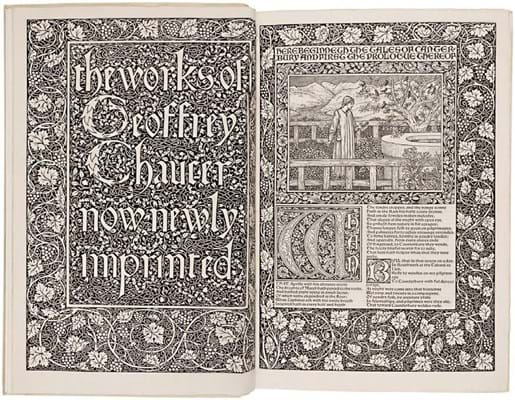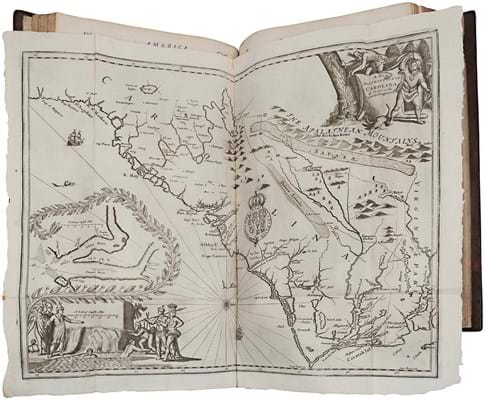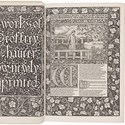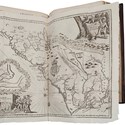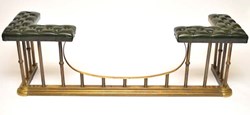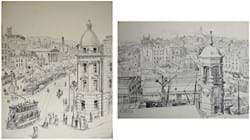The copy of the 1896 Kelmscott edition of Chaucer’s works that made $60,000 (£46,510) at the auction on October 8 was one of the 425 paper copies that many years later, perhaps in the early 1930s, was handsomely rebound in vellum gilt by Peter Franck, an American craftsman who was particularly proud of this example of his work.
Good times, bard times
The First Folio sold by Christie’s New York a week later for close on $10m (see ATG No 2464) is the big Shakespeare story of recent times, but here a rather more modest $22,000 (£17,055) was bid on just the 22pp alloted to The Merchant of Venice in that famous 1623 edition.
In a restored 19th century binding of blind tooled tan morocco by the Guild of Women Binders, a 1685, Fourth Folio edition did, however, sell at $65,000 (£50,390) in Chicago.
Of similar age, but appealing to a very different market, a fine and wide marginned copy of the 1671, first English language edition of Arnoldus Montanus’ America…, with the text translated, adapted and enlarged by John Ogilby, made $28,000 (£21,705).
Profusely illustrated with doublepage engraved maps and views, as well as numerous text illustrations, this revised second issue copy was first owned by Charles Palmer, or Fitzroy, an illegitimate son of Charles II and Barbara Villiers, Duchess of Cleveland, who later became Duke of both Cleveland and Southampton.
In 2019 Hindman set an auction record for Darwin’s On The Origin of Species… in selling the fine ex-Paul Mellon/Garden copy at $460,000 (then £357,420) but while the copy sold at $90,000 (£69,765) on this occasion was nowhere near so finely preserved, it did contain a laidin note presenting Mr Darwin’s compliments.
Five Seven Pillars
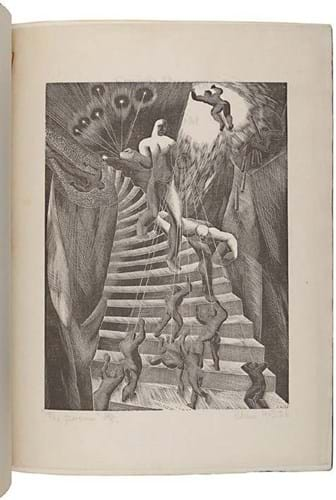
The rarely seen wood engraved plate by Blair Hughes Stanton, illustrating the dedicatory poem ‘To S.A.’, from a presentation first of TE Lawrence’s 'Seven Pillars of Wisdom' sold for $60,000 (£46,510) at Hindman.
Once in the Spiro family collection, which boasted no fewer than five of the 170 privately printed copies of the 1926 edition of TE Lawrence’s Seven Pillars of Wisdom, an example containing a warm presentation inscription and including an extra plate by Blair Hughes Stanton – found in only four of the ‘complete’ copies that Lawrence gave to special friends – realised $60,000 (£46,510).
This one was given to Colonel Robert Buxton, a commander of the Imperial Camel Corps who had played a major part in the 1918 campaign to cut Turkish railway links to Damascus and who in later years, as a friend and bank manager, had helped fund the subscriber’s edition.
First sold at auction at Sotheby’s in 1985, it made $45,000 (then £24,325) in a Christie’s New York Spiro collection sale of 2004.
Bid to $30,000 (£23,255) was a three-volume, first-edition set of Tolkien’s Lord of the Rings bearing the ownership signature of George Sayer, a close friend who, after Tolkien’s initial, unsuccessful attempts to get the trilogy published was supportive and influential in persuading him not to despair and to re-submit the work.
Estimated at $4000-6000 but sold instead at $28,000 (£21,705) was a letter in which Tolkien writes to say that Allen & Unwin are “…now clamouring to reconsider the Lord of the Rings”, and that when he comes to visit he needs to pick up the manuscript, which he hopes he has by now finished reading.
During that visit, and at Sayer’s urging, Tolkien also made the first recorded readings from The Lord of the Rings – which still survive.
An African-American and Black History section of the Hindman sale included among its more successful entries an inscribed, presentation first of Martin Luther King’s Where do we go from Here: Chaos or Community of 1967. It made $6500 (£5040).


